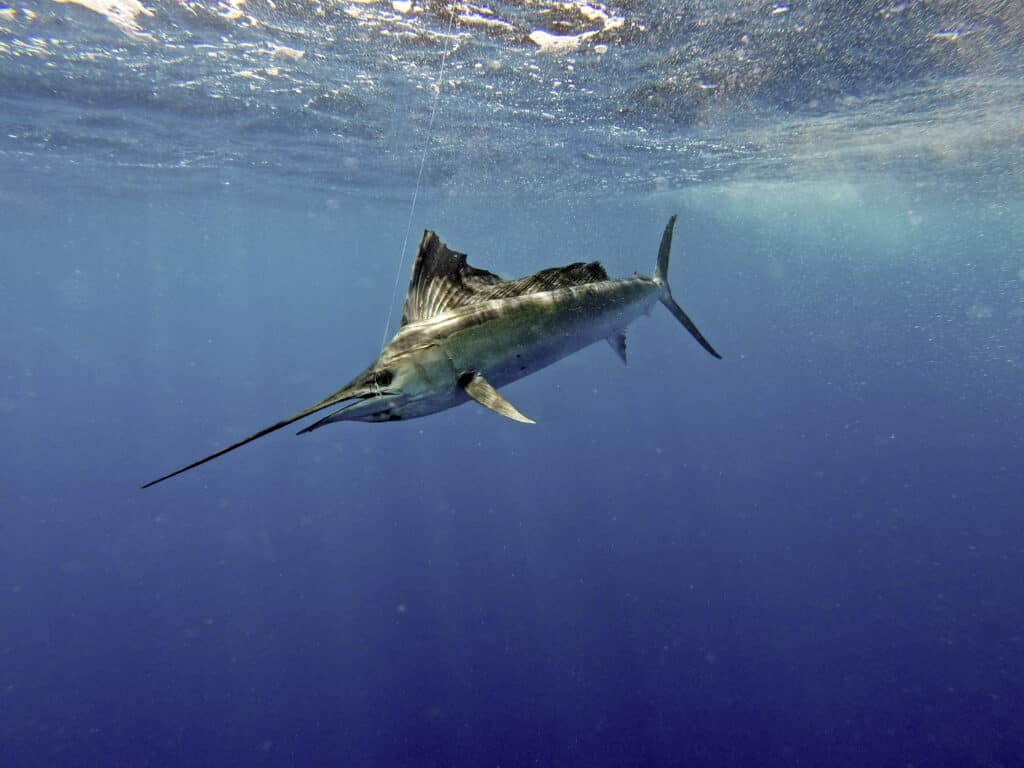This video throws us right into a group of the fastest fish in the world, the sailfish. The narrator explains that these fish grow to three meters (nearly 10 feet) long! Because they are constantly on the move, they must use their energy wisely. A large group of baitfish appears, and we learn why these fast fish are grouped; it’s time to eat! There are nearly 100 sailfish here, a rare occurrence. They do hunt in groups, but not usually so many. The individual sailfish raise huge dorsal fins (sails) and swim around the group of baitfish, herding them. If one of the sailfish strikes at the wrong time, they could injure or kill one of their kind. They have adapted to be able to warn each other what direction they are going.
Watch the Fastest Fish in the World do What it Does Best: Hunt!
They use the colors of their bodies, kind of like a blinker on a car. It tells the other hunters where they plan to move. They can change from blue to striped to black in a matter of seconds! The color changes also confuse the prey, making it easier for the sailfish to grab one and eat it. These fast fish drive the baitfish toward the surface of the water, and seabirds dive from the air to pick them off. The baitfish frantically swim, but there is nowhere to hide. The video goes on, showing these magnificent fish hunting and eating the smaller fish. They must eat daily to keep their energy up, as they never stop moving. The incredible video linked below is a stunning underwater capture of the fastest fish in the world!
How Fast is the Fastest Fish in the World?

Sailfish do hunt in groups, but usually not as large as the one in our video.
©wildestanimal/Shutterstock.com
Sailfish can swim at speeds of up to 68 mph (or over 100 kmh). That’s the same speed the fastest land animal, the cheetah, can run! There are two types of sailfish, the Atlantic sailfish (Istiophorus albicans) and the Indo-Pacific sailfish (Istiophorus platypterus). Some scientists maintain that the Atlantic sailfish is not a separate species but an adapted version of the Indo-Pacific sailfish. Regardless of the species, sailfish are number one on the top 10 fastest fish in the world list. Others that make the list include swordfish, mako sharks, and common tuna. Another fast fish is the black marlin, which looks similar to a sailfish.
Some newer reports state that the sailfish rarely swims at top speed. They only reach these speeds in short bursts while hunting. This is similar to cheetahs, also.
What Animal Hunts Sailfish?

Sailfish are the fastest fish in the world.
©kelldallfall/Shutterstock.com
They may be the fastest fish in the world, but they still have predators. These fish start life at only a few millimeters long. At this stage, they are easy prey for any fish that want to eat them. As they grow, the size of their predators increases, also. Adult sailfish reach up to 10 feet long and weigh up to 220 pounds. These adults fear only the largest ocean predators like sharks, orcas (killer whales), and dolphins.
The risk to sailfish by humans is significant, despite the lack of monetary value in them. These fish are not widely eaten due to their tough meat, but they are often caught accidentally. This includes catches with longlines and driftnets. Thankfully, reports by the National Marine Sanctuary Foundation state their numbers are normal. They are not on any endangered species lists.
Is it Normal for Sailfish to Hunt Together?

Sailfish have been observed to be group-oriented when it comes to feeding and hunting and are known to assemble together when attacking schools of fish.
©lunamarina/Shutterstock.com
Sailfish can live a life of solitude or congregate in large groups. When it comes to hunting, a large component of their predator/prey interactions appears to be individualistic. However, they have been observed to also be group-oriented when it comes to feeding and hunting and are known to assemble together when attacking schools of fish. They use these large groups to drive the schools of fish toward the surface where they are able to coordinate attacks from all sides, corraling their prey into what is called a bait ball.
When sailfish hunt with a group, their attacks aren’t coordinated like they may be with an Orca. These fish will swim into a bait ball and blindly strike out, which results in injuries to the targeted fish. They may not catch their targets on the initial pass but upon wounding them, they become susceptible to the group of sailfish, which lends their strategy a higher success rate than solo hunting.
How Large are Adult Sailfish?

Ernest Hemingway caught a fairly large sailfish off the coast of Florida in the 1940s.
©Florida Memory, No restrictions – License
The size of a sailfish depends on where they are located. They can grow, from bill to tail, anywhere from 5.7 to 10 feet, with weights ranging from 130 to 220 pounds. The largest sailfish ever caught was near Santa Cruz Island in Ecuador’s Galapagos National Park and is said to weigh 221 pounds and reach over 11 feet in length.
The photo featured at the top of this post is © kelldallfall/Shutterstock.com
Thank you for reading! Have some feedback for us? Contact the AZ Animals editorial team.







